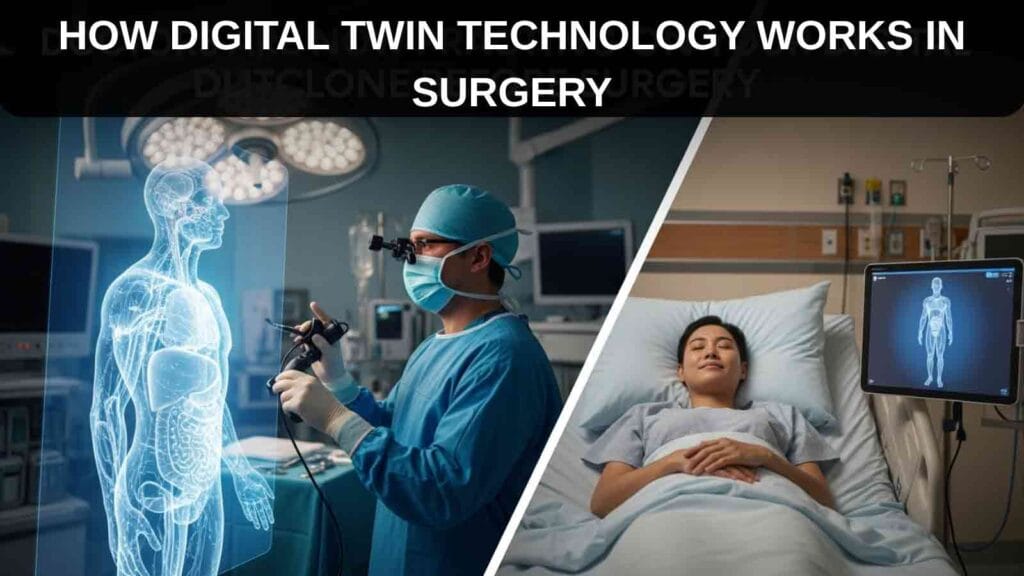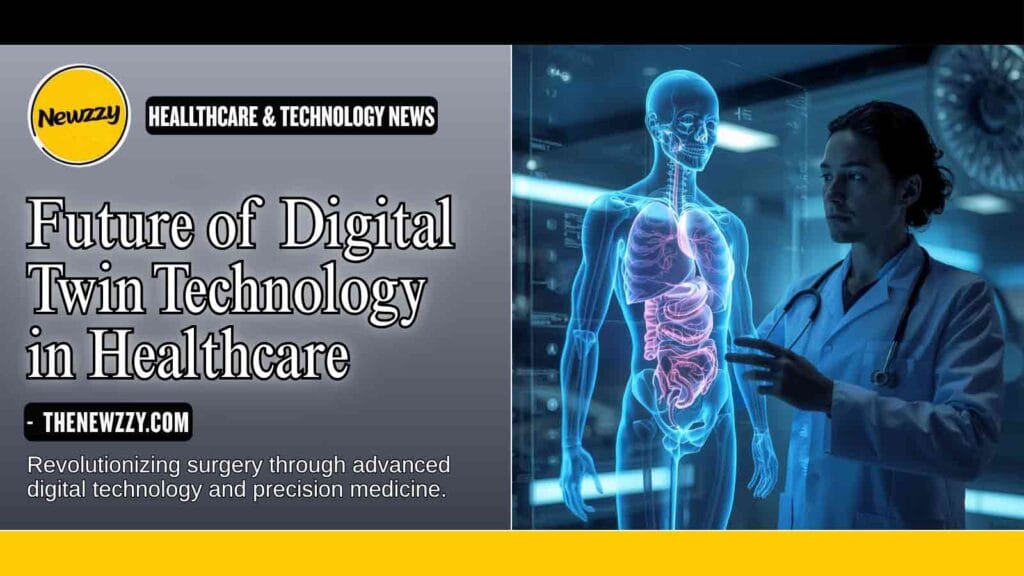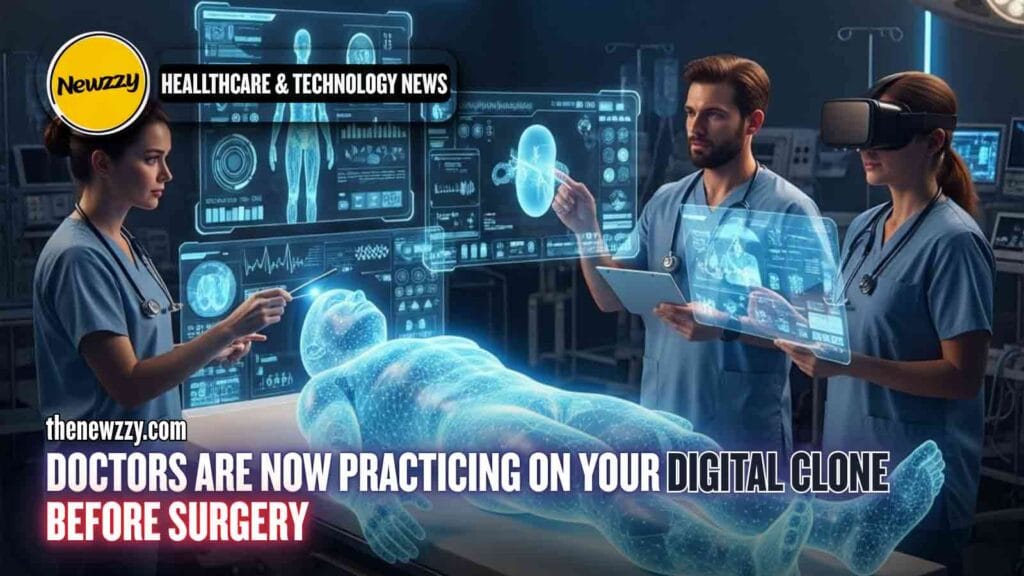What is Digital Twin Technology?
A healthcare digital twin is a simulation of a real human being, organ, tissue or even a system such as a hospital that runs on real time medical data. It is not a fixed image; this model is a dynamic living simulation, which is continuously adjusted to provide additional physiological changes in the patient in real time.
The strength of this twin is in its capability to combine huge heap of information into a single effective model. The enabling technologies that are propelling this fusion are enormous: Artificial Intelligence (AI) processes the entire complex biological data; the Internet of Things (IoT) offers real-time data streams of wearable sensors, and high-resolution imaging of MRI and CT scans gives the underlying geometry of the anatomy.
Read About: Top Scientists Discovers New Reverse Aging Drugs—Here’s What 2025’s Discoveries Reveal
These components combined allow building a simulator in which specific biology of a patient is precisely mapped. This virtual clone enabled clinicians to observe what a particular dosage of drug can do, how disease progresses, how surgery will cut the real patient by not touching the actual patient.
Table of Contents
FAQs
What is digital twin in health care?
A digital twin is a computer simulation of a patient, organ, or biological system created based on real-time medical data, which can give physicians an opportunity to test their options and surgical procedures on the computerized model as well as real patient.
Do digital twins have their already implemented uses in hospitals?
Yes, such institutions as Siemens Healthineers and the University of Miami are innovating digital twin applications, especially as concerns more generic procedures such as heart surgery, and also to greater diagnostics.
What is the power source of digital twins?
AI is vital in terms of processing big volumes of intricate biological datasets, simulating the actions of the body in response to different interventions, predicting the consequences of the treatment, and prescribing the most optimal treatment.
How are the advantages of utilization of digital twins in surgery?
Digital twins significantly minimize the risk of surgery, allow an extraordinarily personalized care of a patient, and enhance accuracy of the operation by being highly simulated and planned before the actual surgery.
What are the obstacles that prevent the use of digital twins?
The primary obstacles to the ubiquitous implementation involve safeguarding patient data, resolving sophisticated ethical issues (such as ownership), assuring the precision of the AI models as well as handling the excessive computational expenses required to execute these simulations.
What is the future of digital twin healthcare?
It means that in the future, the digital twins will be fully integrated with metaverse consultations, wearable IoT clothing will stream endless data, and quantum AI will be used to simulate human biology and disease development more accurately than ever seen before.
How Digital Twin Technology Works in Surgery

To translate an actual breathing, living patient into a working virtual clone is a data-consuming process of multiple steps.
- Data Collection and Fusion: The process commences with the total gathering of patient-specific data. This entails high-fidelity anatomical data of MRI and CT scan, physiological data of wearable devices (heart rate, blood pressure, glucose levels), detailed electronic medical data (genomics, family history, lab results), and even lifestyle data.
- Creation of AI-Powered Models: This data, which is complex, multi-layered, is ingested by advanced AI and machine learning algorithms. The AI in turn compiles and combines these two different things to make a 3D, dynamic, biomechanically valid model- the digital twin of the patient. This is not a mere picture; it is a good representation and simulation of how the organ moves, pumps and reacts to stimuli.
- Surgical Simulation and Prejudice: Physicians utilize the computerized model as a test bench. They will be able to do the planned surgery: incision by incision, placement of devices by placement of devices, on the digital clone. The twin instantly prefigures the biomechanical and physiological effects of each action. This prophetic ability is priceless.
In this case, a surgeon may experiment with a number of different strategies used in the heart valve repair and determine which one offers the most appropriate blood flow and the least amount of stress to the surrounding tissue. In neurosurgery, the twin is utilized in mapping the safest path to a tumor which would cause the least damage to important regions of the brain. Cancer treatments are also being put to the test with the technology being able to predict the impact that a certain dose of radiation or chemotherapy will have on a particular tumor and healthy cells of a patient.
Real Case of Digital Twin in Healthcare
The digital twin technology is also shifting out of the laboratory and being put to real clinical practice with the support of large world healthcare innovators.
Siemens Healthineers and Dassault Systemes are leading mass undertakings. The simulation expert Dassault Systemes introduced the Living Heart Project, and the larger Virtual Human Twin project. It is a grandiose project aimed at developing incredibly precise and even personalized simulations of the human organs to hasten the research and enhance the treatment planning process.
One of the pioneers in the United States is the University of Miami that leverages digital twins to find out how different interventions would influence patients with heart disease. This means that in modeling the structure and function of individual hearts, cardiologists can accurately customize the placement of devices or surgical procedures by bypassing the traditional trial and error method of doing so.
In addition to surgical planning, such companies as Philips and GE Healthcare are working on the creation of AI twins in the hospital management and patient monitoring. These computer models maximize complicated hospital logistics, and part of them forecast patient flow and resource demand, and deliver an early warning of patient deterioration as indicated by the simulated data patterns. The possibilities of digital twins to increase diagnostic accuracy and clinical success rates have been reported in earlier research papers and provided a sound basis to enable wider adoption.
Advantages of Digital Twin Technology in Medicine

The benefits of applying digital twins in clinical practice are enormous, as they affect patient care at both ends of the spectrum, considering individual patients and the worldwide research ecosystem.
The main advantage is individual therapy and decrease in preoperative risk. The aspect of surprise is removed when surgeons undertake a complex procedure on a virtual replica. They will be able to predict complications; select the most suitable instruments, and create an ideal surgical strategy which will be specific to the anatomy of the patient and result in the short term and long-term improvements.
Digital twins help in the detection of diseases at an early stage, which is through simulation models. Researchers need to run what-if scenarios on the twin which will simulate how diseases such as diabetes or Alzheimer will progress several years down the line. It makes it possible to take proactive lifestyle interventions and preventive treatment and detect issues before being severe.
At the operational level, the technology causes computerized workflow in the hospital and the medical machine pre-assessment. Hospital systems The computer avatars of hospitals can simulate resource scheduling and placement, minimizing the wait time and increasing efficiency. Moreover, by predicting the time an MRI machine may require maintenance, depending on its virtual performance, this will help them avoid the expensive and risky down time.
Lastly, medical R&D saves money and time immensely with the technology, drug companies can test new compounds on virtual groups of patients without the necessity of conducting costly and lengthy conventional clinical tests. This enhances the route towards saving lives in the lab bench to the bed-side of the patient.
Ethical and Privacy Problems
Regardless of the potential shown by tremendous scope, the mass application of digital twins faces severe ethical and privacy issues, which should be taken into account.
The fundamental issue is patient data security. The information used to build the digital twin is made up of one of the most sensitive granular health data imaginable, such as genomic sequences and real-time physiological measurements. It is most important to keep this valuable and personal information out of the reach of breaches and abuse.
There is a complicated issue of ownership: Who is the owner of the digital twin? This is not the patient whose body and data were used as the model. Is it the hospital, which gathered the information? Or is it the software developer who established and upholds this proprietary simulation engine? There should be clear legal frameworks in order to get rights and access defined.
Also, the problem of AI bias and accuracy is dangerous. In case the AI algorithms that form the twin are trained on inappropriate or defective data, the resulting model would be misleading and hence wrong predictions and wrong surgical strategies will be made. It might be disastrous in case of a risk of wrong predictions, and AI development should be thoroughly checked and publicized.
Lastly, it is essential to comply with such regulations as HIPAA in the U.S. or GDPR in Europe. The future of AI healthcare that relies on consent requires a new basis of patient consent, that is, simply being educated and agreeing to the use of their profound personal information to build and control their virtual personalities.
Development of Digital Twins in Medicine Till 2035

The decade ahead will see the digital twin technology being developed not as a surgical tool that is rather specialized, but as a foundation of a new medical infrastructure.
We look forward to a smooth connection of quantum computing that will give the processing capabilities needed to simulate the cellular and molecular biology of humans in real time. The emergence of the metaverse will be intermediate too, as doctors worldwide will be able to meet and consult each other on the virtual twin of a patient in a common, immersive space.
Some notable future use would be the digital twin personalized medicine and drug testing. Alternative to mass-producing drugs, pharmaceutical firms will follow the path of testing drugs on single patient twins to replicate drug efficacy and drug toxicity and create custom-made drugs with zero side effects. The final aim is the idea of virtual hospitals, when a substantial part of the diagnostic and predictive work is done by the AI-based medical planning systems operating with a population of digital twins, making the physical hospitals oriented towards the acute and emergency treatment.
According to Dr. Richard Barker, the leading scientist on personalized medicine, he says in the future (2035) the standard of care on any serious condition will be to in-silico trial a digital twin of the patient before any physical procedure is conducted. This professional forecast puts emphasis on the unavoidable shift towards the fully simulated medical future.
Future of Digital Twin Technology
Digital twin technology is a tsunami in the medical practice domain, it literally transforms medicine as a reactive intervention into predictive science. Creating living breathing virtual replicas, doctors will be in a position to practice the future in an optimal manner to improve care prior to a single cut.
We are at the beginning of a new era of medicine, an era in which patient care is a complex data-driven ecosystem. The instrumentation of aerospace simulation is what characterizes the quality of the operating room. This transformational ability requires us to perceive our health, and the future of health care, in the data perspective.
It is very possible that the doctor of tomorrow will be more familiar with your health than you are yourself since they already treated your digital self.

